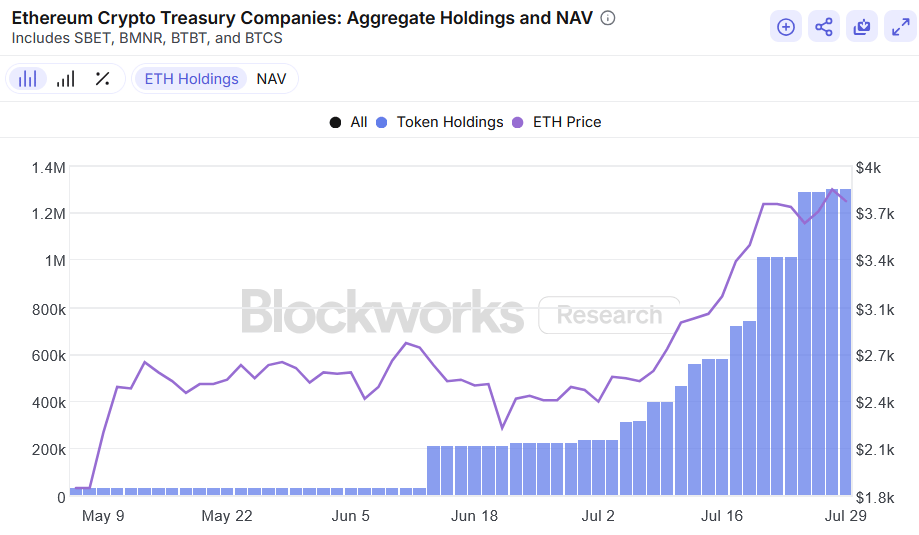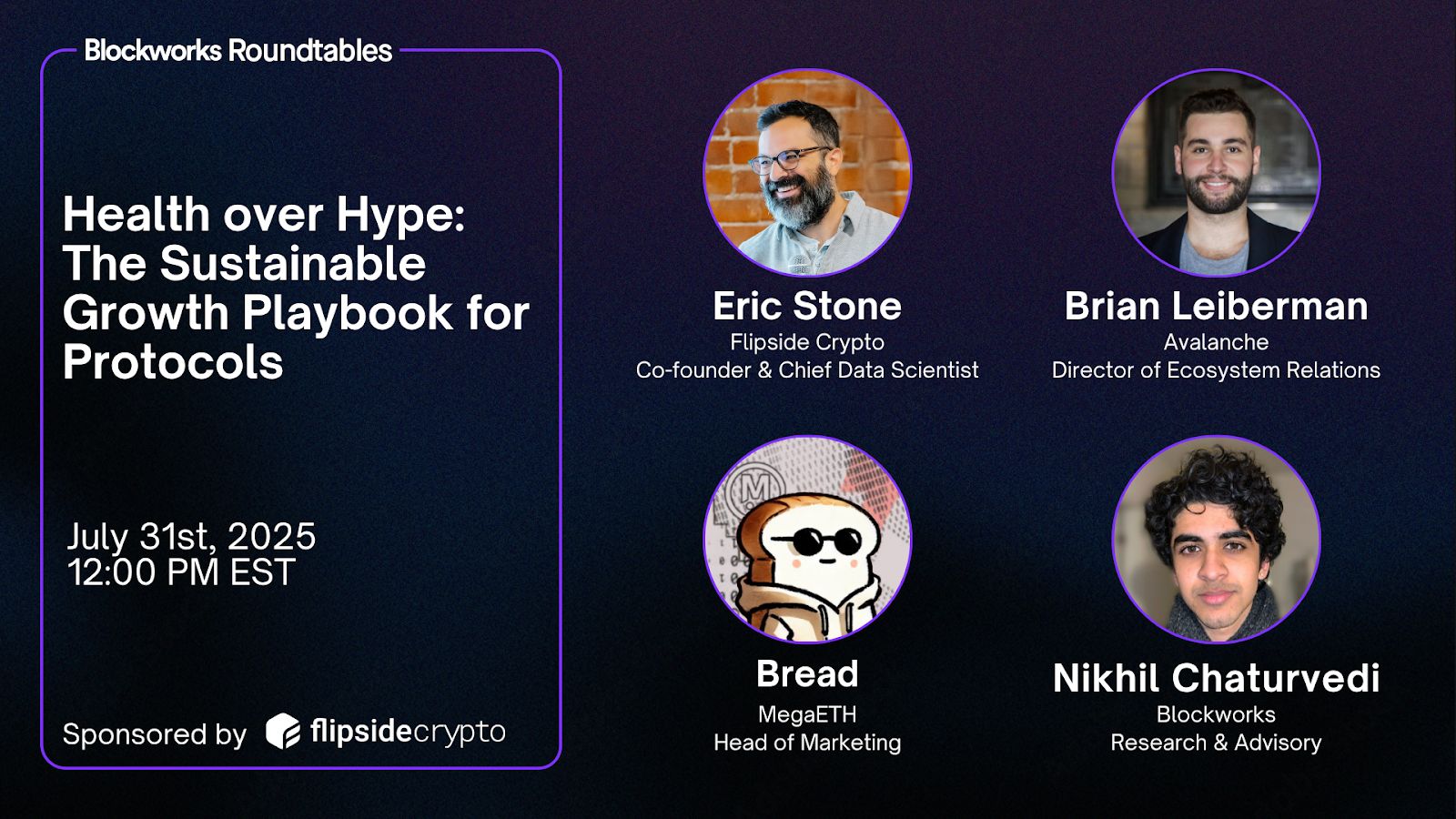- 0xResearch
- Posts
- 📝 Ethereum at year 10
📝 Ethereum at year 10
Reflections on Ethereum’s journey

Ethereum mainnet launched 10 years ago today. After sixteen upgrades and billions in capital, it’s still just getting started. 10 voices reflect on what Ethereum has become, and what it still needs to be.
— Macauley

ETH DATs:

Source: Blockworks Research
In the last month, ETH has rallied from $2k+ to $3.8k. The above chart illustrates a strong correlation between ETH’s recent price rally and the growing Ethereum token holdings acquired by Ethereum Digital Asset Treasuries (DATs).
A total of 1,300,811 ETH ($4.9b) — about 1% of ETH’s supply — are held by SharpLink Gaming (BET), Bitmine Immersion Technologies (BMNR), Bit Digital (BTBT) and BTCS Inc. (BTCS).
What differentiates Ethereum DATs from Bitcoin’s is its ability to stake for an extra 3-4% yield. For instance, Arkham data shows SharpLink as having most of its ETH held in Alluvial’s institutional-grade LsETH (Liquid Staked Ether), or staked with Figment validators.
Crypto has no shortage of short-term hype cycles. The best protocols buck the trends and build sustainable ecosystems for the long haul.
Join Blockworks Research, MegaETH, Flipside Crypto and Avalanche for this upcoming Roundtable. Tune in live to ask the speakers a question!
📅 July 31 | 12 pm ET
10 reflections on Ethereum’s 10th anniversary
Ethereum’s first decade has taken it from a fringe experiment to the potential backbone of digital finance. Below, 10 builders, researchers and market watchers explain what that journey has meant, and where the next 10 years may lead.
We open with Michael Egorov, founder of Curve, who reminds us of just how far things have come: “Ethereum is turning 10 years old: The time flies! Over that time, it has grown from an idea to the foundation of the new financial system.”
For Kirill Fedoseev of Blockscout, that the foundation is now an ecosystem: “Ethereum turning 10 marks more than just the anniversary of a single chain. It’s a celebration of an open ecosystem that’s driving some of the most important infrastructure innovation in Web3.”
Anurag Arjun, co‑founder of Avail and Polygon alumnus, quantifies the scale‑up: “The ecosystem growth is unprecedented: from 15 transactions per second to 24 million daily transactions across multiple layers, 127 million active wallets, $75 billion in DeFi protocols.” Those numbers, he argues, vindicate the modular, rollup‑centric thesis.
Networking expert Muriel Médard of Optimum points to adaptability: “What attracted me most to Ethereum was seeing a decentralized network that could actually evolve and improve over time, and 10 years in, that adaptability has been validated repeatedly.” Her next priority is a faster networking layer to “strengthen how information flows between all stakeholders.”
Markets are noticing. Shawn Young of MEXC notes that “this is due to the shift in the institutional perception of Ethereum…spot Ether ETFs [have logged] 16 consecutive days of net inflows totaling over $5 billion.”
Yet usability still lags. Vikram Arun of Superform observes: “10 years in, Ethereum feels less like an experiment and more like critical infrastructure…The next 10 years will be defined by cohesion at the product layer: fintech‑like mobile apps with seamless UX.”
Rob Viglione of Horizen Labs underscores the slow grind behind that cohesion: “Over the past 10 years, Ethereum’s growth has often felt slower than we anticipated…but in reality, we’ve made meaningful progress in solving many of these issues.” He expects privacy — via technologies such as fully homomorphic encryption — to dominate the next cycle.
Steven Goldfeder, co‑founder of Offchain Labs, is motivated by the runway ahead: “What keeps me most excited…is its untapped potential paired with the community’s dedication to transparently and openly building a better system.”
Aryan Sheikhalian of CMT Digital sounds a cautionary note: “Even if ETH accrues value through blobspace, Ethereum risks becoming the TCP/IP of crypto: essential, invisible, commoditized.” Remaining the cultural and economic center, he says, requires owning standards, liquidity and UX — not just settlement.
Finally, Hart Lambur of UMA and Across sketches the end‑state: “The real endgame is straightforward: a giant payments and exchange network that connects every blockchain.” Achieving that will hinge on seamless interoperability and the liquidity battles it will ignite.
From visionary beginnings to trillion‑dollar ambitions, these 10 voices agree on one thing: Ethereum’s first decade was merely the preface. Scaling trust, usability, privacy and culture for the world is an ongoing project.
What I return to as truly novel is Ethereum’s global scale and resilience. Spend a few minutes on the “10 Years of Ethereum Livestream” and you find celebrations jumping from Toronto to Buenos Aires, Barcelona, Lagos and Mumbai. As a truly decentralized network, it has succeeded in maintaining virtually 100% uptime across 10 years and 16 hard forks. That’s a level of resilience that no other network has been able to match.

What does Ethereum’s roadmap look like?
Marc Arjoon: Dencun was last year and Fusaka has been established for later this year with PeerDAS as the headline. The conversation is now on next year’s Glamsterdam upgrade and what will be included. On the last developer's call, devs were debating between ePBS and cutting the block times into half at six seconds. One takeaway during the call was that core devs are leaning toward ePBS, but they recognized that the community wanted six-second block times. It’s refreshing to see them talk more about what the community wants from a more holistic point of view. And then even more importantly, Ethereum gas limits have increased 50% for the year. That's something to commend — I'm hoping for at least 60 million by the end of the year.
Solana’s roadmap ahead
Carlos Gonzalez: Solana made its first compute units (CU) increase on its block size limits this year from 48m to 50m — a 4% increase. Now, it’s doing a 20% increase (50 to 60) and eventually 60 to 100. It’s part of Anza’s plan to roughly double block space, starting at 48 and targeting 100 by [end of year]. It’s questionable if there is demand to actually have 100m CU limits. What we’ve seen onchain was that blocks weren’t always filled, so is it really necessary to keep increasing it and risk potential downsides? The goal is to keep supply in line with periods of huge demand like the TRUMP memecoin launch or the PUMP ICO but I'm not sure if there's sufficient demand onchain today to justify rushing a 200m CU increase. The pace that Solana is executing at right now is on track with market demand.
Ian Unsworth: It’s also probably important to build for edge cases. Solana is right now risking becoming Ethereum in the sense that the chain is only as fast as its slowest client. Firedancer is still very underutilized. Increasing CU limits to get more network stake running Firedancer will allow increasing transaction output and give more rewards to stakers.

|
|
